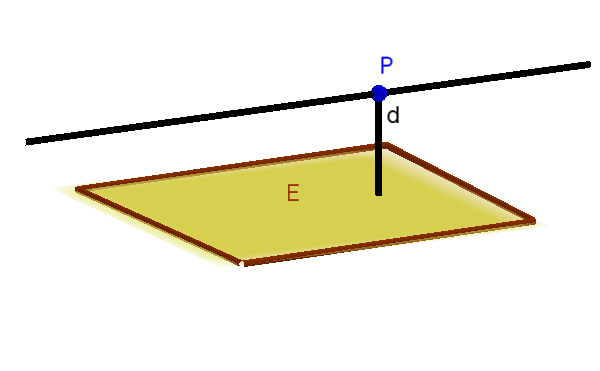Distance of a line / plane to a parallel plane
The distance is the length of the shortest connection.
If a line and a plane are parallel to each other, then they are at a constant distance.

The same applies to two parallel planes.

Info
As you can see in the picture above, the distance is nothing more than the distance of a point to the plane. Since both are parallel, any point can be selected and inserted into the Hesse normal form of the plane.
Example (line and plane)
$\text{g: } \vec{x} = \begin{pmatrix} 1 \\ 2 \\ 1 \end{pmatrix} + r \cdot \begin{pmatrix} 1 \\ 1 \\ 0 \end{pmatrix}$
$\text{E: } \left(\vec{x} - \begin{pmatrix} 2 \\ 1 \\ 1 \end{pmatrix}\right) \cdot \begin{pmatrix} 2 \\ -2 \\ 4 \end{pmatrix}=0$
-
Check parallelism
Since the distance can only be calculated if there is parallelism, you have to check whether the line and the plane are parallel.
In order to keep it as simple as possible, we look at whether the normal vector of the plane and the direction vector of the line are orthogonal to each other. The scalar product must be zero.
$\begin{pmatrix} 1 \\ 1 \\ 0 \end{pmatrix}\cdot\begin{pmatrix} 2 \\ -2 \\ 4 \end{pmatrix}$ $=2-2+0$ $=0$
-
Select point
You can take any point on the line. However, since you can easily read the support point, this is a good option.
$P(1|2|1)$
-
Set up Hesse normal form
$|\vec{n}|=\sqrt{2^2+(-2)^2+4^2}$ $=\sqrt{24}$
$\vec{n_0}= \frac{\vec{n}}{|\vec{n}|}$ $=\begin{pmatrix} 2/\sqrt{24} \\ -2/\sqrt{24} \\ 4/\sqrt{24} \end{pmatrix}$
$\text{E: } \left(\vec{x} - \begin{pmatrix} 2 \\ 1 \\ 1 \end{pmatrix}\right) \cdot \begin{pmatrix} 2/\sqrt{24} \\ -2/\sqrt{24} \\ 4/\sqrt{24} \end{pmatrix}=0$
-
Insert point
$\vec{p}=\begin{pmatrix} 1 \\ 2 \\ 1 \end{pmatrix}$
$d=$ $\left|\left(\begin{pmatrix} 1 \\ 2 \\ 1 \end{pmatrix} - \begin{pmatrix} 2 \\ 1 \\ 1 \end{pmatrix}\right) \cdot \begin{pmatrix} 2/\sqrt{24} \\ -2/\sqrt{24} \\ 4/\sqrt{24} \end{pmatrix} \right|$ $=\left|\begin{pmatrix} -1 \\ 1 \\ 0 \end{pmatrix} \cdot \begin{pmatrix} 2/\sqrt{24} \\ -2/\sqrt{24} \\ 4/\sqrt{24} \end{pmatrix} \right|$ $=|-\frac4{\sqrt{24}}|$ $\approx0.82$
Example (plain and plain)
$\text{F: } \left(\vec{x} - \begin{pmatrix} 1 \\ 2 \\ 1 \end{pmatrix}\right) \cdot \begin{pmatrix} -4 \\ 4 \\ -8 \end{pmatrix}=0$
$\text{E: } \left(\vec{x} - \begin{pmatrix} 2 \\ 1 \\ 1 \end{pmatrix}\right) \cdot \begin{pmatrix} 2 \\ -2 \\ 4 \end{pmatrix}=0$
-
Check parallelism
Since the distance can only be calculated if there is parallelism, you have to check whether the planes are parallel.
We look to see whether the normal vectors are parallel. In contrast to the line, there is no check for perpendicularity.
$\vec{n_1}=r\cdot\vec{n_2}$
$\begin{pmatrix} -4 \\ 4 \\ -8 \end{pmatrix}=r\cdot\begin{pmatrix}2 \\ -2 \\ 4 \end{pmatrix}$ $\Rightarrow r=-2$
There is an $r$: The vectors are multiples of one another and therefore parallel.
-
Select point
You can take any point on the plane. However, since you can easily read off the support point, this is a good option.
$P(1|2|1)$
-
Set up Hesse normal form
$|\vec{n}|=\sqrt{2^2+(-2)^2+4^2}$ $=\sqrt{24}$
$\vec{n_0}= \frac{\vec{n}}{|\vec{n}|}$ $=\begin{pmatrix} 2/\sqrt{24} \\ -2/\sqrt{24} \\ 4/\sqrt{24} \end{pmatrix}$
$\text{E: } \left(\vec{x} - \begin{pmatrix} 2 \\ 1 \\ 1 \end{pmatrix}\right) \cdot \begin{pmatrix} 2/\sqrt{24} \\ -2/\sqrt{24} \\ 4/\sqrt{24} \end{pmatrix}=0$
-
Insert point
$\vec{p}=\begin{pmatrix} 1 \\ 2 \\ 1 \end{pmatrix}$
$d=$ $\left|\left(\begin{pmatrix} 1 \\ 2 \\ 1 \end{pmatrix} - \begin{pmatrix} 2 \\ 1 \\ 1 \end{pmatrix}\right) \cdot \begin{pmatrix} 2/\sqrt{24} \\ -2/\sqrt{24} \\ 4/\sqrt{24} \end{pmatrix} \right|$ $=\left|\begin{pmatrix} -1 \\ 1 \\ 0 \end{pmatrix} \cdot \begin{pmatrix} 2/\sqrt{24} \\ -2/\sqrt{24} \\ 4/\sqrt{24} \end{pmatrix} \right|$ $=|-\frac4{\sqrt{24}}|$ $\approx0.82$
